There’s a pile of thick, silky leaves between my hands. They are a deep, shiny, dangerous green, beautiful to run my fingers over, and just a bit alarming at the same time. Even the botanical name, Remusatia vivipara has a wild, unpredictable ring to it, like the forest from which it has been plucked and brought to my kitchen, a wildness usually hidden by the friendly sounding Hitchhiker Elephant Ear, the name by which it is commonly known.
Mara kembe is a glossy forest beauty that flourishes during the monsoon in Coorg. It grows on trees, drawing vital nutrients from its hosts, producing concentrations of anti-oxidants that make it a wonder cure in native medicine for an astonishing range of common ailments and serious diseases. But mara kembe does not yield up its healing properties quite so easily. It comes with a wicked little twist, a generous dose of ‘raphides’, needle sharp calcium oxalate crystals that can cause a severe irritation in the throat that can even be fatal to browsing animals. A good dose of acid, usually generous squeezes of native limes, or some kachampuli, is used to neutralize this toxin and make the leaves edible.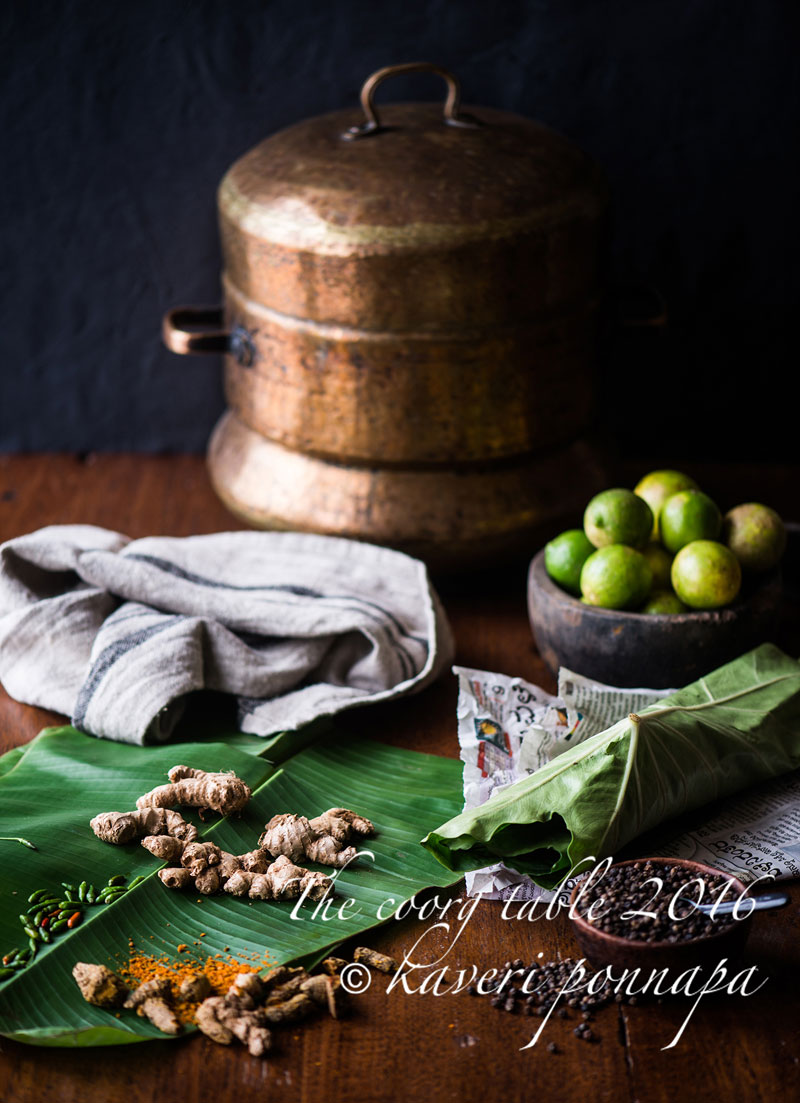
In tangled, luxurious, rain-soaked forests, mara kembe comes into its own from June to September, when the rains beat down across Coorg. Rich with nutrients and anti-oxidants it was cooked and eaten to keep body temperatures stable during the cold, wet windy weather that lasted for months, when people spent much of their time outdoors, working the rice fields. Mara kembe puttu is a throwback to the cold, wet, hard days of the past.
A roll of green leaves, tied artistically with a length of some dried forest creeper lies on the floor of my kitchen. It has just arrived from Coorg, along with a precious haul of juicy, thin-skinned native limes, their skins mottled and rain battered, but their flavour undefeated. There’s a bundle of fiddlehead ferns that already has me dreaming of a tender stir-fry. Roots, shoots and leaves tumble out of a bag. I approach the mara kembe leaves with caution and respect after a tasting incident gone wrong –I accidentally dipped my finger into a paste of raw leaves to taste for salt. The fierce burning and itching took so long to die down, I doubt if I will ever make the same mistake again!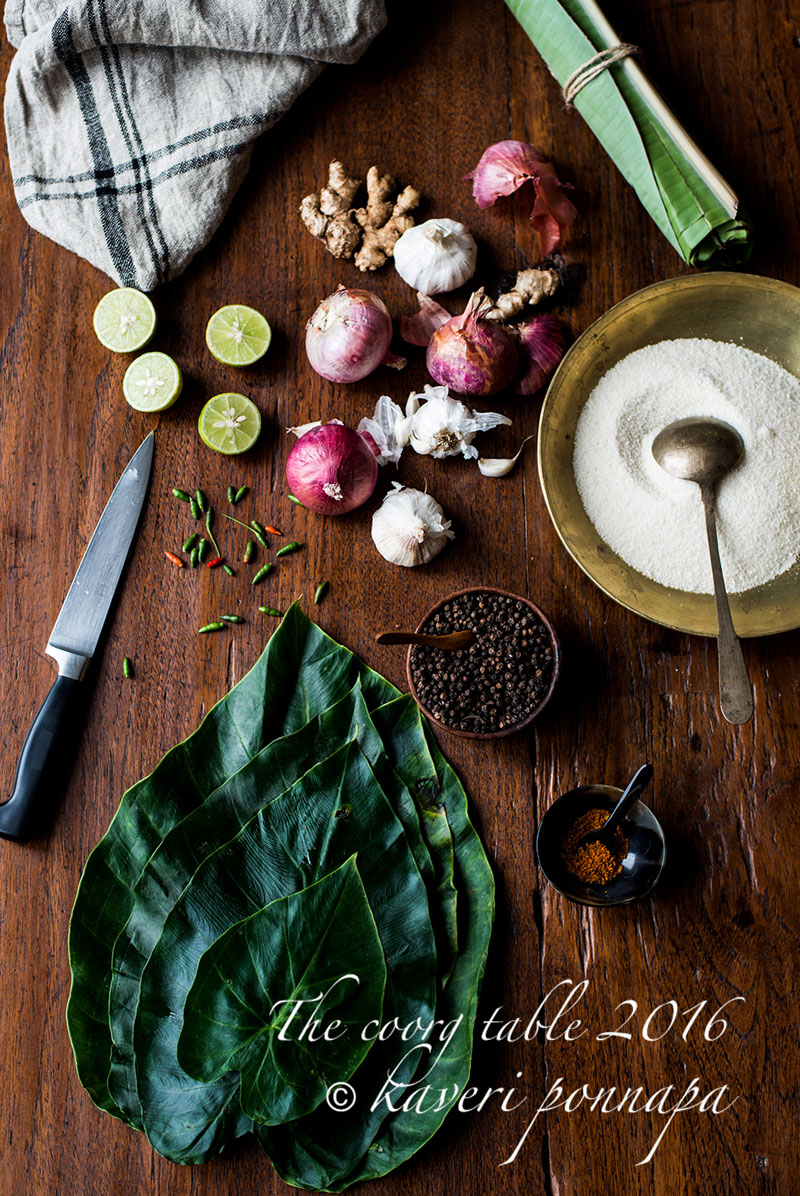
I grind the thick, rich leaves with spices, taming their ferocity with copious quantities of limejuice and steaming them into rice puttus wrapped snugly in banana leaves. This is one of the most beautiful puttus I have ever eaten. The soft parcels open up to release a warm fragrance of forest scents and a rich green colour that has survived the steaming. I would quite happily eat it just as it is, to explore every nuance of that wild taste. But you can mellow the flavours a little, seasoning the puttu it with a little chopped onion; mustard seeds and curry leaves fried in a spoon of ghee if you wish. The stems of mara kembe go into a curry, and the tubers are eaten too. But that’s a story for another time.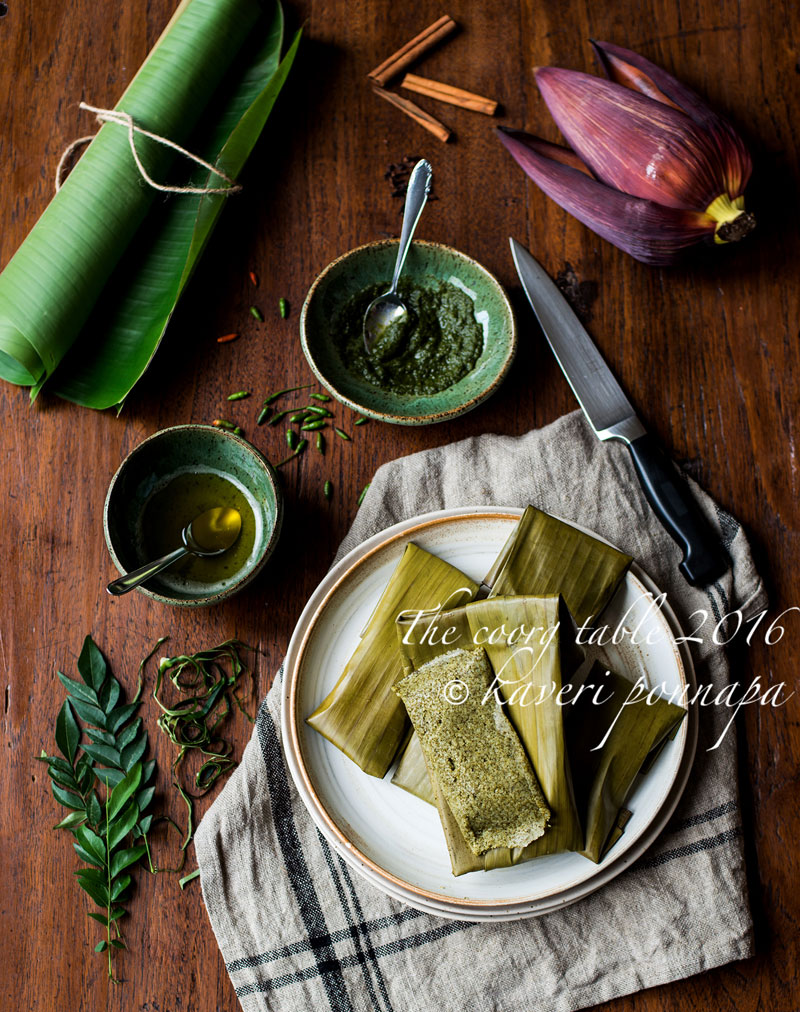
Kakkada, which runs through mid-July to mid-August, is a season that comes with myths and folklore of its own. The rain beats down –or at least, it did –so relentlessly that it was believed that even the gates to heaven were closed, an unsuitable time to die. The forest was always a dark, dangerous and uncertain place that one entered with caution to gather food, even more cautiously when the skies were sullen and the earth sodden with rain. Under those skies, the stories grew darker too, weaving webs of myth around foods that were commonly eaten. Colocasia esculenta, the familiar Taro, a relative of mara kembe, popular in curries the year through was enmeshed in a tale of spirits during kakkada. Since the gates to heaven were closed to good people, kulis, malignant, mischievous spirits used this ambiguous time to travel to heaven themselves. They would go away, leaving their children tied to the safety of the stems of Taro plants during kakkada. If you dared to eat Taro during this month, you harvested it at your peril! With mara kembe puttu on your table, fragrant, delicious, filled with so much goodness that extensive scientific research is being done into its remarkable curative properties with the idea to include it in pharmaceutical medicines, why would you want to test out that little myth anyway?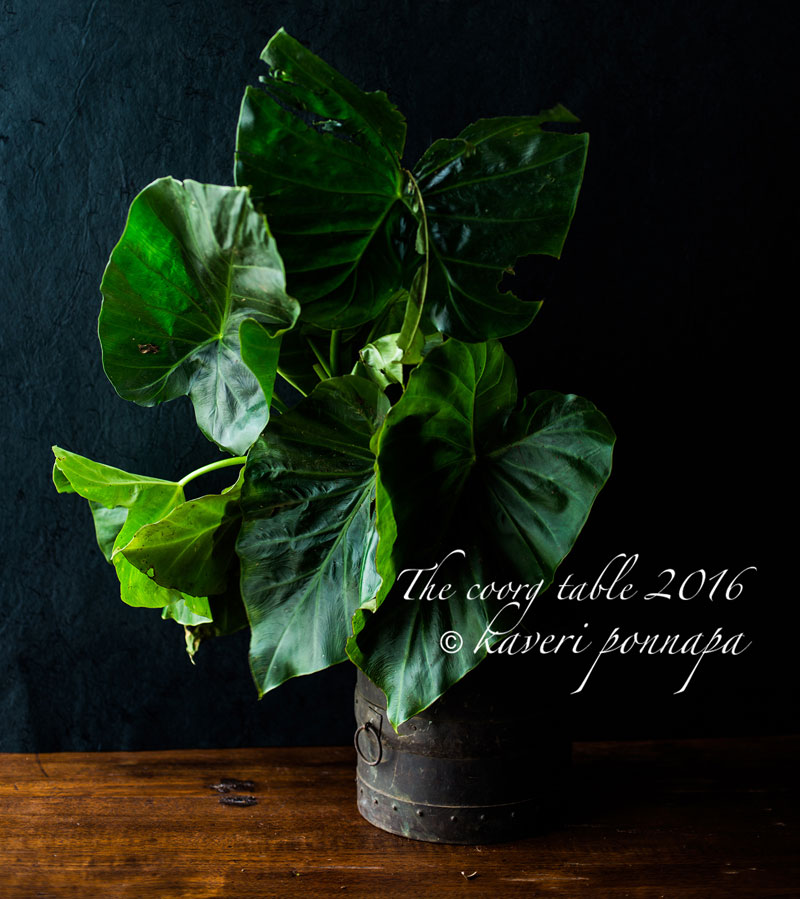
Photo Credits: Nithin Sagi
All Food Styling: Kaveri Ponnapa
Please look out for this recipe in my upcoming cookbook.
Thank you for visiting this page. If you read something that you enjoy, or see an image that you like, please take a moment to write a response. Do look out for the recipes of all the food featured here in my upcoming cookbook.

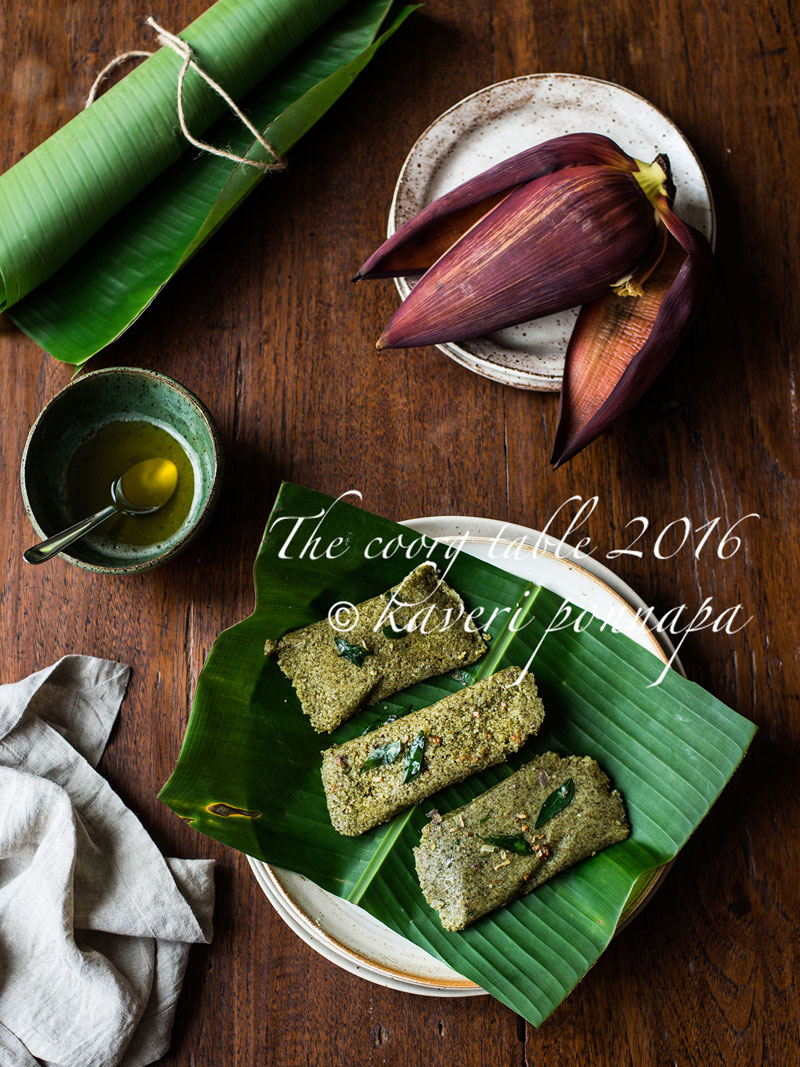
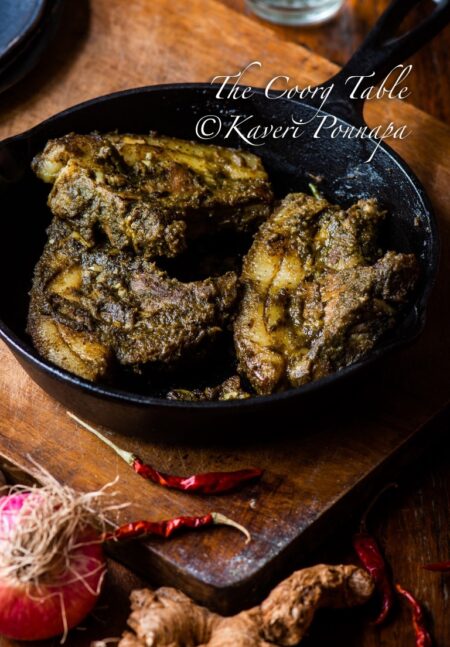
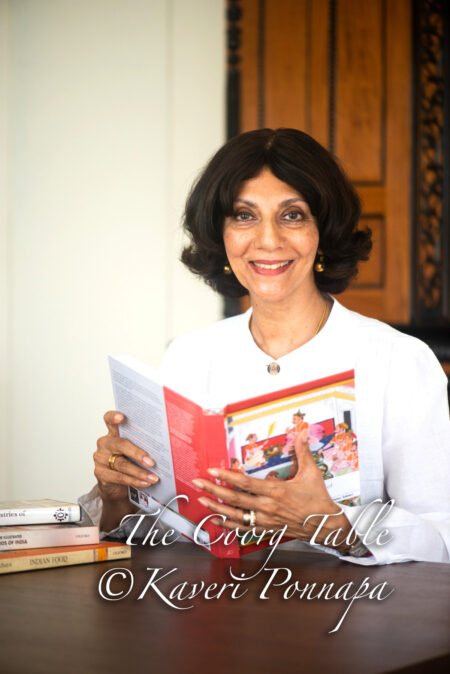
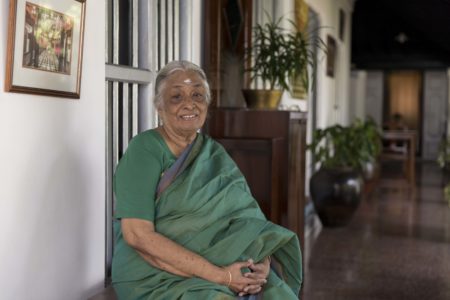
Dear Kavery Aunty,
Thank you for taking me back to my roots and memories I cherish the most. As you said in one of your posts the 2 things I can’t stay without are my Sakala and Palyakathi. I can’t wait for you to release the book there are so many recipes I want to try.
Hello Sonal, I hope that you won’t have to wait too long. It’s so good to hear you say that The Coorg Table takes you back to your roots. My book is taking its own time, but I promise you, it will be worth the wait. In the meanwhile, please keep your sakala and palyakathi going—they are such wonderful pieces of kitchent equipment, with so much history attached to them. Warm wishes. Kaveri
Hi Kaveri
I was wondering if your book is on sale . Really looking to lay my hand on a copy
Culinary regards
Ricky madappa
Hi Ricky, please bear with me. The book will definitely turn up, it’s just taking its own time, the way that books tend to! Thank you very much for your interest, do keep reading. Best wishes. Kaveri
So nicely written! I have eaten Kembu, dishes made from Kembu thand, but I never heard about mara kembu puttu. Wow so nice to see these types of dishes and also stories related to it…Thank You!!
Like you, I had also not eaten Mara Kembe Puttu, Kaverappa, but it was a very popular peak monsoon (Kakkada) food. A kind friend gave me some general instructions and I worked out the recipe after some trials.It is one of the most delicious puttus I have ever eaten, so rich, moist and full of forest flavours. I know that I will be making this every year during the season,in addition to the curries.Very glad you enjoyed the post, please keep reading! Warm wishes.Kaveri
How lovely! Thank you for sharing a story about this plant.
I’m glad you enjoyed reading the post, Emma. I hope there will always be something to interest you on these pages.Kaveri
What a beautifully written article, Kaveri. So happy to learn about this plant. I would love to grow it here in Goa. I wonder if it grows on a particular type of tree? Or any old host will suit this hitchhiker?
Thank you very much Rosie, and after our exchange on trees and hosts, I hope that you are able to grow this successfully in Goa. I’m sure you’ll have plenty of local knowledge on how it is eaten to share soon, and I look forward to that.
Thank you for bringing such beautiful stories Kaveri. I love the stories of spirits and how they had a strong presence in minds of earlier civilizations.
Coorg was once very,very densely forested,if fact, there are historical accounts recording how the only way through the countryside was with the help of local guides.The wilderness was a powerful presence in everyday life, Sangeeta. There are so many fascinating and beautiful stories linking the forest and spirit world to the food we eat.I’m so glad you enjoy the blog, do keep reading and I always welcome responses.
Thanks for sharing beautifully written story of Mara Kembu, she’ll be blushing😊it feels extravagant and exotic reading about Coorg food through your eyes! I love each of those flavours of all the unique natural stuff from the wilds. I am in anticipation of your write ups that keeps me connected to the distant Coorg and its ethnic beauties. It’s such a pleasure reading at leisure with a cuppa, rejoicing in the visual treats on your blog, thanks a ton!
I can imagine how much you might miss these flavours, Sujaya, and I’m really happy that the blog keeps you in touch with things that you love. When I lived overseas,one of the things I packed and took with me was my sakala! I was sure that I did not want to do without familiar puttus and curries, it was my way of staying connected. Thank you very much for your appreciation,each post has a life of its own, no matter how much I try and plan, especially the images.Please keep reading and writing in. Warm wishes.Kaveri